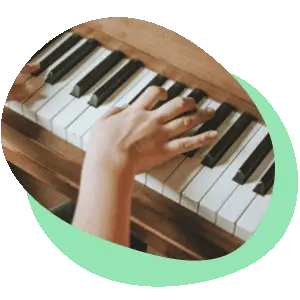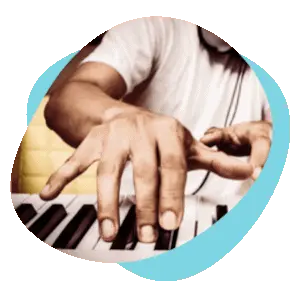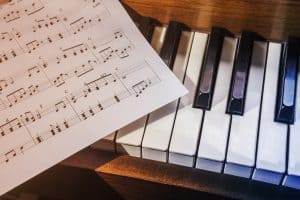Understanding the notes on a piano is a bit like learning a language – it might take a bit of time at first, but once you’ve mastered how it all works, you’ll be able to play whatever you want!
This early effort is crucial, as it builds the foundation for musical expression, allowing you to communicate through melodies and harmonies.
As you familiarize yourself with each key and its tone, playing music will become as intuitive as speaking your native language.
Key takeaways
- The piano notes come with letters and all keyboards use the same 7 letters for white keys: A, B, C, D, E, F, G
- All keyboards use the same white key and black key pattern
- We can identify any position on the keyboard by looking at just two notes
- Sheet music is notated on 5 lines and spaces called a staff

No credit card details required
What are the notes on a piano?
Each of the notes on a piano has a letter name and these piano notes are ordered just like the English alphabet. You can learn also about piano notes numbers. In music, we label the notes from A to G and then repeat from A again. Here are the piano notes with letters for the white notes on a keyboard:

The black piano keys have names too. There are actually two possible names for them: the # sign means “sharp” and the b sign means “flat”.

But if you’re looking to learn piano notes for beginners, focus mainly on the white keys for now, avoiding the complexity of advanced musical terms like passing notes. If you’re unsure where the notes on a keyboard are, remember:
- C is to the left of the group of two black notes
- F is to the left of the group of three black notes
All the notes for piano are arranged in octaves. This means that there is a group of eight notes, all notes on piano can combine different groups of 8, like piano abc notes (C, D, E, F, G, A, B, C) and then we move onto the next group of eight, following the same pattern. The octaves to the left side of the keyboard piano notes have a low pitch; the octaves to the right side of the keyboard have a high pitch.
The right-hand notes will be written in the treble clef and the left-hand notes will be written in the bass clef. This way, you’ll be able to cover all notes on the piano without any trouble!
Note recognition and landmark notes
There are different ways to practice piano notes for beginners and as you go forward with your learning, you’ll likely draw on all of these at different times. There are essentially three approaches to master as you learn how to play piano:
- Note recognition and landmark notes
- Interval recognition
- Pattern recognition
The following piano note guide highlights the advantages and disadvantages of each method and should help you decide which one is best for you and learn piano notes letters songs.
Did you know?
Pianos and keyboards come in all sorts of different shapes and sizes. A full-scale grand piano has 88 keys, while travel size MIDI-keyboards have as few as 12 which are piano notes on keys.
Note recognition
This approach involves recognizing all the notes of the grand staff. Many teachers use mnemonics to aid memorization here.
You might be familiar with some of these already. Let’s start with the treble clef notes:
Perhaps you are familiar with some of them already? Take a look at the following image and then match up the mnemonics with the note names.

Note that the mnemonics start from the bottom and move upwards, and apply to just lines or just spaces. The piano notes labeled for the spaces in the treble clef spell the word “face” and play a note.
And now onto the bass clef, which follows the same principle but with different note letters :

The pros and cons of note recognition reading
Pros:
- A great approach when you need to be very specific, perhaps when doing some music theory or trying to communicate with someone else. For example, your teacher might say “let’s take it from F in the first measure”.
Cons:
- Very time consuming.
- Can make it harder to learn piano intervals.
Landmark notes
Recognising landmark notes has become a popular approach for learning piano notes especially piano key notes. Rather than remembering all the piano with notes, as the above method did, you can just remember four landmark notes on each stave. This is much easier to do, so your accuracy and speed of learning should increase.
Now that you have a strong foundation you’ll be able to read piano notes chart and adjacent notes using the interval method (coming up next).

The pros and cons of landmark notes
Pros:
- Quick and easy way of learning the notes on piano.
- Encourages the development of sight reading.
Cons:
- Can be difficult to troubleshoot. For example, if you play something that doesn’t sound right and you want to double-check if you’re correct, but what if the questionable note isn’t a landmark note?
Interval recognition
This is a more intuitive way of learning how to read piano sheet music. It’s used in combination with the landmark note method. You start by identifying the first note and next follow the shape of the music – does it move upwards or downwards, does it move by step or skip, or does it stay in the same position?
Now, move onto the next note based on its relationship to the note you are playing. All this can be done without needing to name the note you move to. It feels like giving your fingers permission to respond to the shape of the music, and it’s a very effective way of practicing piano notes.
Our Skoove lesson on the song ‘Twinkle Twinkle Little Star’ is a fantastic way to practice the interval recognition approach.
Once you’ve grasped moving from one note to the next by way of intervals, have a go at trying some basic piano chords, for which you’ll have to play more than one piano note at a time.
The pros and cons of interval recognition
Pros:
- Instead of treating each individual note as a separate entity, we look at all notes together. A musician can play entire measures of music in seconds, instead of working through one note at a time.
Cons:
- If you mistakenly move to a higher or lower note than you should, all of the other note relationships will be incorrect as well.
- Reading intervals also requires the pianist to think carefully about which key they are in.
Best ways to remember piano notes
Reading piano sheet music is not only a combination of reading note names and intervals – sometimes the piano note values and names are not the most important thing. We learn how to read piano note names in the same way that we learn to read letters in languages. Ultimately you’ll want to perfect the skill of playing piano by ear.
1. Reading tips
Once you can read from one note to the next using interval recognition, then you can try patterns of 3 or 4 notes at a time, thus forming little musical ‘words’ or phrases’. This is simplest when you only play quarter-note, half-note, or whole-note rhythms. Try not to focus on what the left hand is doing, just play slowly and intentionally.
Our Skoove lesson on Mozart’s Sonata no. 11 is a great way to learn how to remember piano notes!
Learn to play ‘Sonata III’. Start a 7 day trial today – no card details required!
2. Dimensional learning
The concept of dimensional learning in relation to piano notes for beginners means that there are all sorts of supporting skills available to enhance your practicing. Here are four skills that will provide a broader, more connected learning experience:
- Keyboard geography
- Sense of key
- Ear training
- Hand training
3. Keyboard geography
This means knowing the layout of the keyboard. For example, knowing that if you start on middle C and move upwards by a fourth you will land on F (you always include the starting and ending note when counting up or down). The ultimate aim is to find these notes for piano without looking down.
A great place to start practicing this is when you are learning piano scales. Try stopping randomly in the scale and name the note you are on without looking at the keyboard.
4. Sense of key
Knowing what key you are in is one of the most important ways to remember easy piano notes. Fluent music readers don’t just remember notes very quickly, they draw on key knowledge to predict the most likely notes to occur in a song. For example, a piece in G major is highly likely to end on a G. When playing easy piano songs in G major, such as “Twinkle, Twinkle, Little Star” the final note will typically be G. This familiarity with the key helps pianists anticipate and play the correct notes more easily, enhancing their overall performance.
5. Train your ears to recognize notes
Ear training is a vital skill for musicians to develop. In between processing how to read music and coordinate finger movements it is easily overlooked.
Practice this by studying the first four bars of the song ‘Tainted Love’ by Soft Cell, available here on Skoove.
Learn to play ‘Tainted Love’ by Soft Cell. Start a 7 day trial today – no card details required!
One of the great things about taking online piano lessons with Skoove is that consideration is given to understanding the rhythm and general shape of the music. The learning does not lie in the accuracy of your imagined sound but rather in the process and the insights you gain from it.
6. Train your hands to play the right notes
For interval reading to work properly, you must of course only land one finger on each note. This sounds simple, however, initially it can feel quite unnatural. If you are struggling with accuracy in reading or finding progress slow, this could be part of the reason, so remembering to keep only one finger for each note could help you here. Regularly practicing piano scales is really helpful here!
7. Use mnemonic devices
And of course using the mnemonic devices discussed earlier in the ‘Note recognition’ section of this blog can always be helpful.
Common mistakes to avoid when learning piano notes
Here’s a list of the most frequent piano mistakes for beginners and how to avoid them:
- Playing with tense fingers: Playing with tense, flat fingers makes you less agile and slows your progress down. Keep your fingers curved and remember to stay relaxed!
- Playing too fast: It can be so tempting to start out learning the piano notes of songs and piano music notes quickly. But you need to initially play slowly and lock in that muscle memory, otherwise persistent errors will creep in.
- Using too much finger pressure: The power behind pressing the piano keys should come from the arms not your fingers. Otherwise you’ll end up tiring yourself out and will lack the stamina to play longer pieces.
- Not practicing consistently: Frequent practice is vital to improving performance. You should aim for daily practice – even 10 minutes a day makes a huge amount of difference!
- Staying at the same difficulty level: Once you’ve mastered a song, it’s time to move onto a new one. Fortunately there are hundreds to choose from on Skoove! Playing the same thing over and over again means you’re not challenging yourself to attain a higher skill level.
- Learning pieces that are too hard: By contrast, be careful to choose a song that is within your ability range. Otherwise you’ll end up getting frustrated and possibly picking up some bad techniques that can take a long time to iron out.
- (Always) looking down at the keys: This can be a difficult skill to master when learning piano notes. But remember to use some of the tips given earlier in this blog to help you memorize the notes on piano keys!
- Only playing in C major: Songs are easier to play in C major because there are no sharps or flats. It’s a good place to start, but try experimenting with songs in other keys on Skoove.
What does a musician do with all the notes?
Now you should be able to know all notes on the piano. This should make it much easier for you to read written sheet music and will greatly aid your ability to sight-read on piano.
Knowing how to read music notes piano is only a small part of the learning process. Things like intention, emotion, communication, and connection are not notated but are nonetheless essential building blocks of piano playing. So where do you go to learn about such things?
The best place is the Skoove piano app and sign up for a free trial! There are heaps of songs and interesting lessons, including some excellent courses for improving piano technique, to really enhance your understanding of the topics discussed in this blog. You can watch people play the song and slow the speed down as you’re learning, therefore putting into practice many of the tips and suggestions we’ve just covered.
Happy note reading!
Author of this blog post:
Alvin Shipp















